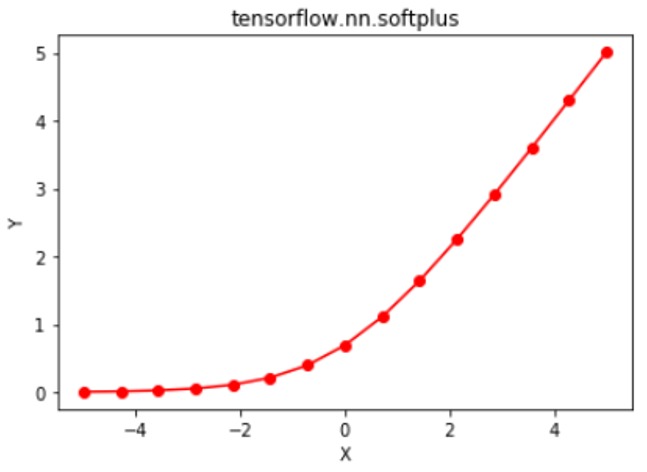Tensorflow是Google开发的开源机器学习库。它的应用之一是开发深度神经网络。
模块tensorflow.nn为许多基本的神经网络操作提供支持。
激活函数是应用于神经网络层输出的函数,然后将其作为输入传递到下一层。激活函数是神经网络的重要组成部分,因为它们提供了非线性,如果没有非线性,则神经网络只能简化为逻辑回归模型。许多激活函数之一是Softplus函数,其定义为![]() 。
。
传统的激活函数(例如S形和双曲线正切)具有下限和上限,而softplus函数的输出范围为(0,∞)。 softplus函数的导数出来是![]() ,这是S型函数。 softplus函数与整流衬里单元(ReLU)十分相似,主要区别是x = 0时softplus函数的可微性。Zheng等人的研究论文“使用softplus单元改进深度神经网络”。 (2015年)表明,相比于ReLU函数,softplus为深度神经网络提供了更多的稳定性和性能。但是,由于易于计算ReLU及其导数,因此通常首选ReLU。激活函数及其导数的计算是神经网络中的常见操作,与softplus函数相比,ReLU提供了更快的正向和反向传播。
,这是S型函数。 softplus函数与整流衬里单元(ReLU)十分相似,主要区别是x = 0时softplus函数的可微性。Zheng等人的研究论文“使用softplus单元改进深度神经网络”。 (2015年)表明,相比于ReLU函数,softplus为深度神经网络提供了更多的稳定性和性能。但是,由于易于计算ReLU及其导数,因此通常首选ReLU。激活函数及其导数的计算是神经网络中的常见操作,与softplus函数相比,ReLU提供了更快的正向和反向传播。
函数nn.softplus()[别名math.softplus]为Tensorflow中的softplus提供支持。
用法:tf.nn.softplus(features, name=None) or tf.math.softplus(features, name=None)
参数:
features:以下任何类型的张量:float32,float64,int32,uint8,int16,int8,int64,bfloat16,uint16,half,uint32,uint64。
name(可选):操作的名称。
返回类型:与特征类型相同的张量。
代码1:
# Importing the Tensorflow library
import tensorflow as tf
# A constant vector of size 6
a = tf.constant([1.0, -0.5, 3.4, -2.1, 0.0, -6.5], dtype = tf.float32)
# Applying the softplus function and
# storing the result in 'b'
b = tf.nn.softplus(a, name ='softplus')
# Initiating a Tensorflow session
with tf.Session() as sess:
print('Input type:', a)
print('Input:', sess.run(a))
print('Return type:', b)
print('Output:', sess.run(b))输出:
Input type:Tensor("Const:0", shape=(6, ), dtype=float32)
Input:[ 1. -0.5 3.4000001 -2.0999999 0. -6.5 ]
Return type:Tensor("softplus:0", shape=(6, ), dtype=float32)
Output:[ 1.31326163e+00 4.74076986e-01 3.43282866e+00 1.15519524e-01
6.93147182e-01 1.50233845e-03]
代码2:可视化
# Importing the Tensorflow library
import tensorflow as tf
# Importing the NumPy library
import numpy as np
# Importing the matplotlib.pylot function
import matplotlib.pyplot as plt
# A vector of size 15 with values from -5 to 5
a = np.linspace(-5, 5, 15)
# Applying the softplus function and
# storing the result in 'b'
b = tf.nn.softplus(a, name ='softplus')
# Initiating a Tensorflow session
with tf.Session() as sess:
print('Input:', a)
print('Output:', sess.run(b))
plt.plot(a, sess.run(b), color = 'red', marker = "o")
plt.title("tensorflow.nn.softplus")
plt.xlabel("X")
plt.ylabel("Y")
plt.show()输出:
Input:[-5. -4.28571429 -3.57142857 -2.85714286 -2.14285714 -1.42857143 -0.71428571 0. 0.71428571 1.42857143 2.14285714 2.85714286 3.57142857 4.28571429 5. ] Output:[ 0.00671535 0.01366993 0.02772767 0.05584391 0.11093221 0.21482992 0.39846846 0.69314718 1.11275418 1.64340135 2.25378936 2.91298677 3.59915624 4.29938421 5.00671535]

相关用法
- Python Tensorflow abs()用法及代码示例
- Python Tensorflow log()用法及代码示例
- Python Tensorflow tan()用法及代码示例
- Python Tensorflow nn.tanh()用法及代码示例
- Python Tensorflow sin()用法及代码示例
- Python Tensorflow cos()用法及代码示例
- Python Tensorflow exp()用法及代码示例
- Python Tensorflow nn.sigmoid()用法及代码示例
- Python Tensorflow logical_and()用法及代码示例
- Python Tensorflow cosh()用法及代码示例
- Python Tensorflow reciprocal()用法及代码示例
- Python Tensorflow acos()用法及代码示例
- Python Tensorflow asin()用法及代码示例
- Python Tensorflow sinh()用法及代码示例
注:本文由纯净天空筛选整理自vaibhav29498大神的英文原创作品 Python | Tensorflow nn.softplus()。非经特殊声明,原始代码版权归原作者所有,本译文未经允许或授权,请勿转载或复制。
